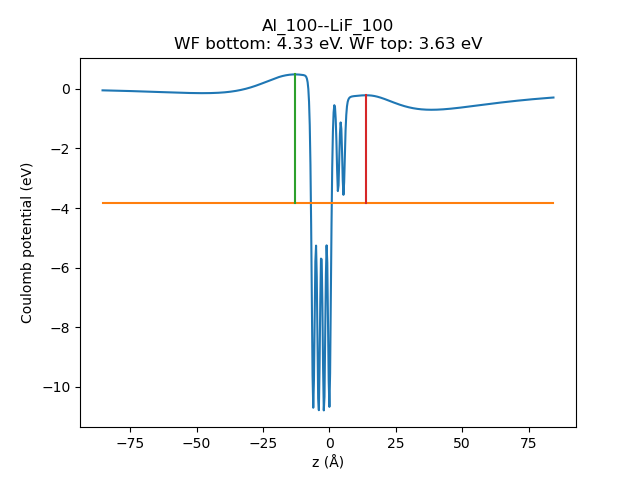Work functions at interfaces¶
This tutorial will show how to use BAND to calculate the work function Φ of the
Al(100)/vacuum interface
Al(100)/LiF(100) interface

Fig. 41 Plane-averaged electrostatic (Coulomb) potential vs z coordinate. The orange horizontal line is the Fermi energy. The red and green vertical lines indicate how the work function is calculated on either side of the slab. The work function (WF) for the Al(100)/vacuum interface (green) is 4.33 eV. The WF for the Al(100)/LiF(100) interface (red) is 3.63 eV.¶
The adsorption of LiF(100) will decrease the work function, as compared to vacuum. The results will be compared to plane-wave-DFT results by Prada S., et al. 1 and Kondo and Matsushista 2
Al(100) Φ [eV] |
Al(100)/LiF(100) ΔΦ [eV] |
functional |
code |
|
Prada et al. |
4.37 |
-0.7 |
PW91 |
VASP |
Kondo and Matsushista |
4.28 |
-0.59 |
PBE |
Quantum ESPRESSO |
This tutorial |
4.33 |
-0.70 |
PW91 |
BAND |
Note
The above works differ not only in code and functional, but also basis set, k-point sampling, number of layers in the Al or LiF slabs, whether the system is relaxed or not, …
When setting up a solid-solid interface, the lattice constants must match. Both Al and LiF are cubic, so if their lattice constants match, also the (100) surface lattice constants will match. At least one of the materials needs to be a bit strained. Here, we will strain the LiF slab to match the Al slab. We will place the LiF slab at a distance of 3.27 Å from the Al slab.
Note
For other interfaces, you may need to apply surface rotations and use surface supercells if the lattice constants of the two materials are very different, in order to not apply too much strain to one of the materials.
Download the LiF-on-Al.xyz file
Select File → Import Coordinates and select the downloaded file
See also
If you are not yet familiar with the editing tools in AMSinput, take a look at our Introduction to Building structures.
First, build the Al(100) slab:
2
Similarly, open a new AMSinput window and create the LiF(100) slab:

We now want to position this LiF slab on top of the Al slab such that the F atom is 3.27 Å directly above the top Al atom

3.27 Å to first atom (the first atom is the first selected F atom)
This has created the desired interface geometry.

Then, set the BAND settings:


0.002 hartree
This sets up a 7x7 k-space grid. The integration, spline zlm fit, and electronic temperature options help with the SCF convergence.
Save and run the job.
To get the work function:
WorkFunctionVacuumAndInterface.pyresults_dir variable to give the correct path to the .results folder from the previous calculation. It should contain two files: ams.rkf and band.rkf.$AMSBIN/amspython WorkFunctionVacuumAndInterface.pyThis produces a plot like the below:

Fig. 42 Plane-averaged electrostatic (Coulomb) potential vs z coordinate. The orange horizontal line is the Fermi energy. The red and green vertical lines indicate how the work function is calculated on either side of the slab. The work function (WF) for the Al(100)/vacuum interface (green) is 4.33 eV. The WF for the Al(100)/LiF(100) interface (red) is 3.63 eV.¶
- 1
Prada, U Martinez, G. Pacchioni. Work function changes induced by deposition of ultrathin dielectric films on metals: A theoretical analysis. Phys. Rev. B. 78, 235423. DOI: 10.1103/PhysRevB.78.235423
- 2
Kondo, T. Matsushista. Vacuum-Level Shift at Al/LiF/Alq3 Interfaces: A First-Principles Study. ACS Omega 2019, 4, 8, 13426–13434. https://doi.org/10.1021/acsomega.9b01667


